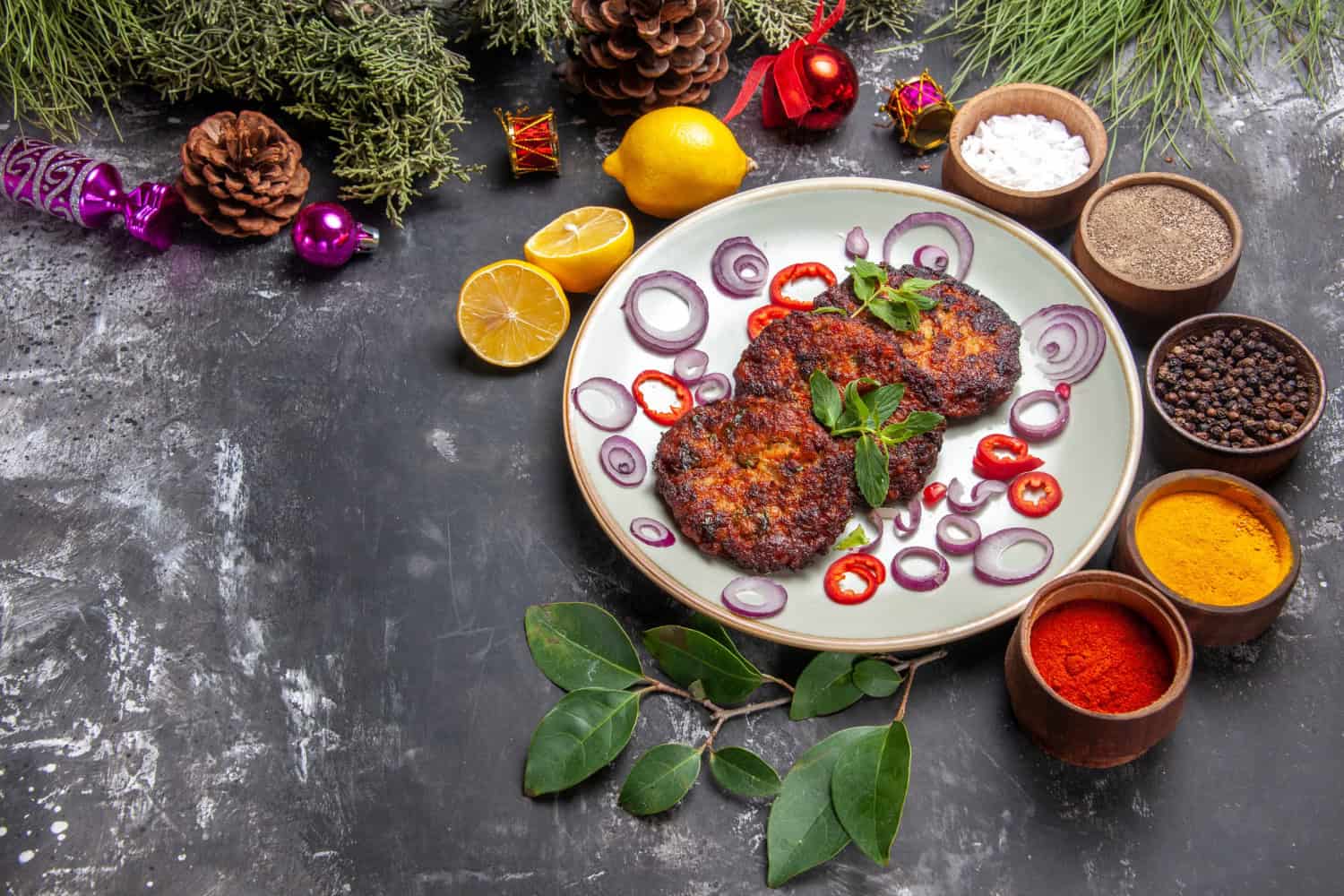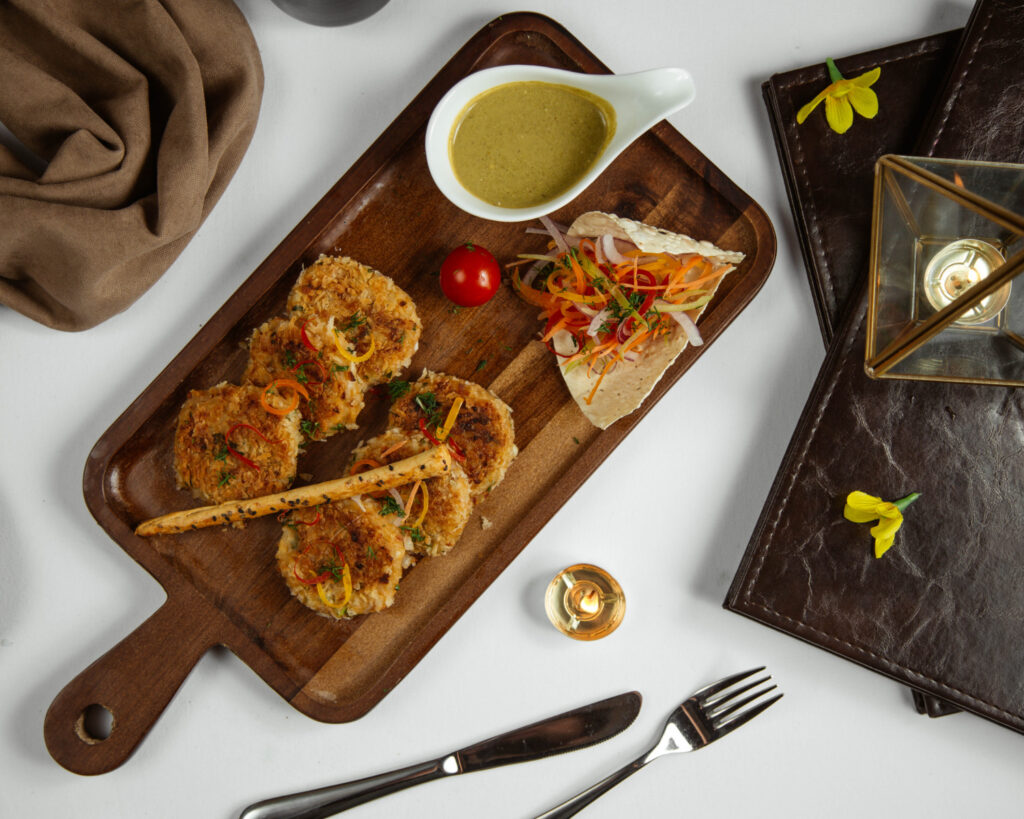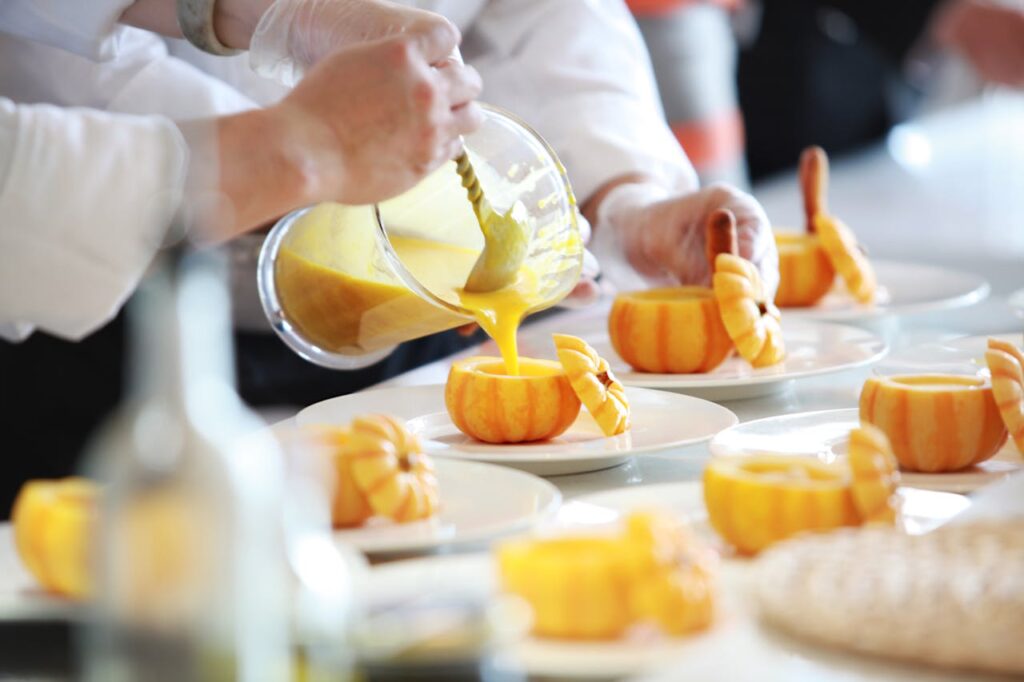
By Jermaine Thomas June 6, 2025
Food serves as more than just sustenance. It is a language of identity, culture, and legacy. The presentation of food is often just as important as its flavour when it comes to catering, particularly in global contexts. Cultural differences in food aesthetics are influenced by regional ingredients, social conventions, and historical practices. To provide genuine and unforgettable culinary experiences in the world of international catering today, it is essential to understand cultural food aesthetics, adjust to different plating styles, and appreciate ethnic cuisine presentation.
The Cultural Meaning Behind Food Presentation
Across the world, food presentation is deeply symbolic and often rooted in tradition. The way a dish is served can convey messages of hospitality, status, and emotion. In many Asian cultures, the balance of colors, textures, and elements on a plate reflects harmony and completeness. In contrast, Western styles often focus on individual portions and artistic flair.
Food presentation in any culture goes beyond looks. It plays into the story of the meal. In some Middle Eastern and African communities, communal eating and shared platters symbolize togetherness and generosity. Meanwhile, Japanese bento boxes reflect meticulous care and attention to detail. These examples show how cultural food aesthetics guide not only what is served but how it is visually shared with others.
Understanding these cultural meanings helps caterers respect traditions while creating a visually pleasing spread that resonates with the guests’ backgrounds and expectations.

From Function to Form: A Historical Perspective
Over the centuries, the art of food presentation has changed. Grand buffets were traditionally displayed by European royalty and aristocracy as a symbol of luxury and wealth. Similar to this, elaborate food arrangements played a major role in religious festivals and rituals in ancient China and India.
Food as visual art has only become more popular. Plating customs were passed down through the generations in many cultures. These include the symmetrical dish arrangements in Korea, the geometric alignments in Thai cuisine, and the colour symbolism in Mexican festival foods. Global catering services must now understand that these customs are significant traditions rooted in time, not just aesthetic preferences.
For example, a caterer preparing an Indian thali for an event must know that the clockwise placement of dishes isn’t random but intentional. It follows Ayurvedic principles of balance. These nuances elevate a meal from a generic buffet to a culturally immersive experience.
Regional Plating Styles and Global Fusion
In global catering, adapting to international plating styles is essential. Each region has its own philosophy on how food should be arranged, portioned, and consumed. Understanding these differences allows chefs and event planners to stay respectful while also being creative.
European plating is known for its emphasis on minimalism and precision. The French often create vertical height in dishes, drawing the eye upward. Italian presentations, while rustic, still emphasize balance and color. In contrast, East Asian styles lean toward harmony, often using square or lacquered plates, with components placed to achieve aesthetic and symbolic balance.
Latin American presentations use vibrant colors and layered textures, reflecting their rich culinary diversity. African cuisine varies widely but often celebrates bold plating, with rich sauces and multi-component dishes that are designed for sharing. Global catering services increasingly face the challenge of balancing these authentic styles with a demand for fusion. While a sushi taco may attract attention, its presentation must still respect the ethnic cuisine display principles from both Japanese and Mexican traditions.
Balancing Authenticity with Creativity
A common challenge for catering businesses is to balance providing inventive, contemporary adaptations of dishes while remaining faithful to their cultural roots. Although guests might value innovation, authenticity shouldn’t be sacrificed for it.
A caterer may serve Peruvian ceviche in a shot glass, for instance, to make serving easier, but the fish cut and garnish must still adhere to the Peruvian technique. Modern serving trays can also be used to recreate a Middle Eastern mezze platter, but the balance and quantity that characterise the traditional spread should be preserved.
Cultural fidelity and creativity can be delivered by international caterers who are aware of these visual storytelling components. Having a solid grasp of the aesthetics of cultural cuisine allows teams to introduce new ideas without sacrificing legacy.
Table Settings and Cultural Symbolism
The way food is presented includes not just the plate itself but also the surrounding environment. Table setting, utensils, and even colors used in linens and garnishes all play roles in respecting tradition.
In Japanese settings, minimalism rules. Plates, bowls, and chopsticks are arranged in a manner that avoids crowding. Garnishes like shiso leaves and edible flowers serve both aesthetic and functional purposes.
In contrast, Indian table settings often use banana leaves or metal platters, known as “thalis,” especially during festivals or traditional functions. Food is not only arranged beautifully but in a particular sequence. Dry dishes go first, followed by wet dishes, sweets, and finally rice in the center. This is a display of both custom and logic, as flavors are intended to be experienced in a certain order.
Mexican catering may involve colorful ceramics, woven mats, and elements of folk art, with food served family-style to invite sharing. Ethiopian meals often feature injera as the base, with different stews spread across it. No utensils are used, making the layout and layering a key part of the experience. Catering companies must invest time in learning these symbolic setups. They are more than decorative details. They are visual cues that guide how guests engage with the food. Respecting these nuances reinforces cultural integrity and enriches the dining experience.
Understanding Garnishes and Cultural Meaning
In many cultures, garnishes serve more purposes than just decoration. They have immense significance. While a sprig of parsley may represent freshness in the West, carved herbs and vegetables are a sign of celebration and respect in Thai culture. Sesame seeds and sliced chillies are used in South Korea to symbolise abundance in addition to adding texture and heat. Slices of orange or spring onions may be added in Chinese cooking to symbolise longevity or good fortune.
Knowing these components makes sure that presentations not only look good but also make sense to people who are familiar with the culture. If culturally odd, even the smallest detail can cause guests to feel misinterpreted.
The Influence of Religion and Rituals on Presentation
Food presentation is also guided by religious customs, which caterers need to understand and honor. For instance, halal and kosher meals require specific plating practices to avoid cross-contamination. But beyond dietary laws, religion influences layout, utensils, and serving rituals.
In Hindu communities, it’s common for meals to be served in a particular order during festivals or weddings, with sweet dishes placed first to signify auspicious beginnings. Sikh langars serve food in rows with equal portions, reinforcing equality. In Buddhist cultures, food offerings during rituals are arranged with great care and symmetry, often reflecting a sense of spiritual mindfulness.
Christian communion ceremonies, Jewish Passover seder plates, and Islamic iftar spreads during Ramadan all emphasize particular sequences and symbolism in layout. In catering scenarios, honoring these rituals through thoughtful presentation is not just good practice but an essential expression of respect.
Catering to Multicultural Events
With the growing popularity of multicultural events, caterers are required to accommodate several customs within a single event. At a multicultural wedding, food from several continents might be served next to each other. This makes the presentation both a logistical challenge and a chance to use food to showcase unity.
The key is intentionality. Instead of a generic fusion buffet, zones can be created for different cultural menus, each maintaining its unique ethnic cuisine display. Visual cues such as traditional fabrics, signage, or serving ware can distinguish and honor the origins of each section. Doing this right means more than just using international recipes. It requires understanding what a well-presented plate looks like in that culture, and what values or emotions it aims to convey.

Technology and the Rise of Social Media Standards
The digital era has transformed food presentation from a cultural necessity into a visual marketing tool. Social media, especially platforms like Instagram and TikTok, have globalized food aesthetics. This has created a new pressure for caterers to design photogenic dishes while still staying culturally authentic. Trends like symmetrical food boards, deconstructed desserts, and edible flowers are influencing global plating styles. However, there is a risk of cultural dilution when presentation is tailored more to likes and shares than to legacy and tradition.
Caterers must research international plating styles while maintaining a traditional foundation in order to strike a balance between the two. Sushi served on marble slabs, for instance, may appear fashionable, but traditionalists might view this as being disconnected from the essence of the dish. Modern ceramic trays with aesthetic appeal that mimic traditional Japanese plating would be a wiser option.
Social media is a powerful tool, but when used thoughtfully, it can showcase cultural diversity instead of flattening it. The best global caterers are those who understand that cultural relevance and digital aesthetics are not mutually exclusive.
Education and Training for Culinary Teams
For global catering companies, the responsibility of cultural awareness lies with the entire culinary team. From chefs to servers, everyone involved must be trained in the basics of cultural food aesthetics. Workshops, cultural immersion experiences, and collaborations with ethnic chefs are excellent ways to build this awareness. Just as chefs train in knife skills or flavor balance, they must also be taught how to plate a Nigerian jollof rice properly or how to fold a Vietnamese spring roll in a traditional manner.
Consistency is ensured and accidental errors that might offend guests or misrepresent a cuisine are avoided through education. Additionally, it promotes a deeper comprehension of international culinary artistry, transforming every occasion into an opportunity to honour culinary diversity at its best.
Final Thoughts on Cultural Sensitivity in Global Catering
Global catering has evolved beyond simply providing food for visitors as the world becomes more interconnected. It’s about using food to tell stories. The first chapter of that story is presentation. Each time a dish is presented, it bears the burden of custom, sentiment, and cultural significance. Food presentation can turn a meal into a cultural adventure, from the arrangement of the ingredients in a thali to the harmony of colours in a sushi platter.
Respecting cultural food aesthetics, adapting to international plating styles, and celebrating ethnic cuisine display is not just a skill but a mindset. It involves empathy, curiosity, and a willingness to learn. For caterers, it’s the key to creating dining experiences that are not only delicious but deeply respectful and memorable. By embracing these principles, catering professionals can create meals that don’t just satisfy the stomach, but also honor the heritage behind every ingredient and arrangement.